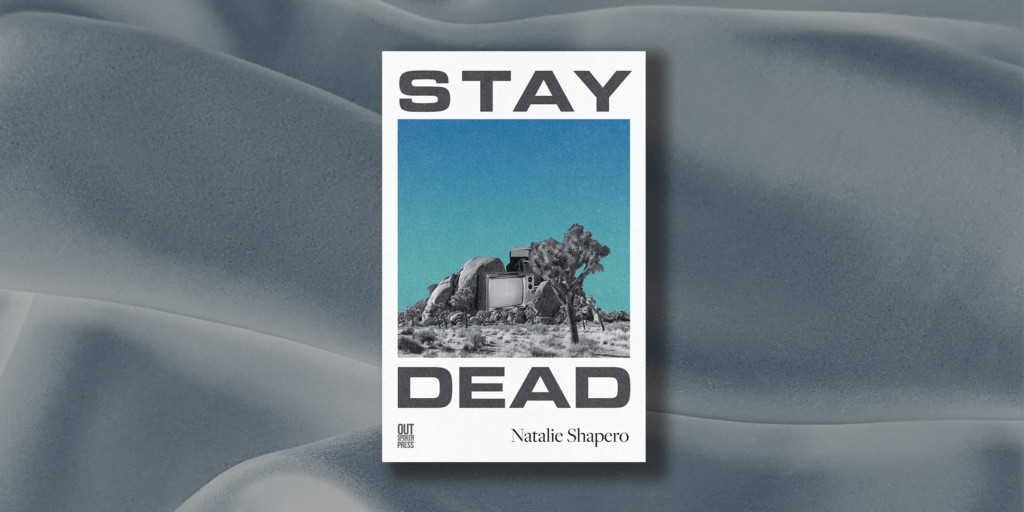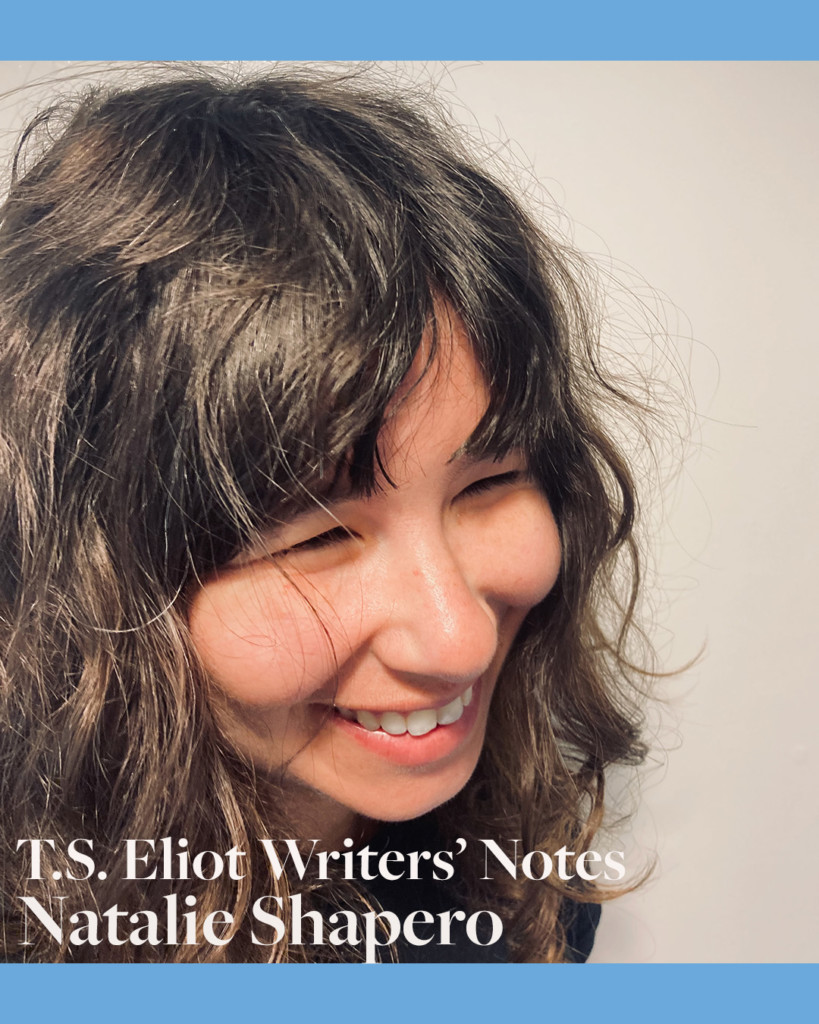Welcome to our Writers’ Notes for the 2025 T.S. Eliot Prize shortlist. These are educational resources for poets looking to develop their practice and learn from some of contemporary poetry’s most exciting and accomplished voices. Here’s Natalie Shapero – T. S. Eliot Writer’s Notes on her collection Stay Dead.

The Way Out
Something I get asked a lot is whether my poems are planned out prior to drafting or whether they are written in a more freeform, follow-your-instincts way. I admire poets who proceed by sound or image or semantic association, letting creative impulses come to the forefront and guide the process, but that has never worked for me. I basically always establish the about-ness of a poem before I start writing it; it’s hard for me to find a way into something if I don’t already have a sense of what I want the reader to take with them on the way out.
Sit Back, Take Note
Working this way requires a lot of advance note-taking, organising, and research. I always have at least one active notebook where I’m putting down anything I think might potentially be useful for future poems: facts, ideas, quotes, specific individual words, arguments and counter-arguments. There has always been something off-putting to me about using a regular, lined notebook for these purposes (self-hatred of being a writer, maybe??), so I like to use planner notebooks instead, which also have the benefit of a few different fields on a given page, so you can divide your ideas visually. Most commonly, I write in an 84-sheet 9.5 x 7.25 Ampad Gold Fibre Project Planner, though I also often write in discarded day planners or other novelty types of journals I find at the thrift store or in giveaway groups. My current notebook is a book for logging daily meditation practice; every other page has a chart for keeping track of mood, mindset, epiphany. A lot of my writing practice involves reading widely on a variety of subjects and keeping notes as I go along. I also take a lot of notes at the movies (recliner-seat theaters are the best for this, just in terms of having the space to easily put down the notebook and pick it up again) and in other cultural spaces, etc.
Distanced Research
I began working on Stay Dead during the early part of the pandemic, when those spaces didn’t exist. At first, I couldn’t write anything and didn’t want to. The first poem I wrote during that time was ‘Kilowatt Hour’ in (I think??) May 2020, and I remember feeling relief that poetry still existed for me, I guess. (I also felt relief that something useful had come out of paying my electric bill. I mean, besides electricity.) That summer, I wanted to get back into reading and research for this new book, which I knew would have a significant thematic focus on both abstract expressionism and method acting. The library system where I lived had started lending out books again. You could request them online and then go to the library and ring a bell or something, and a librarian would bring you the books in a paper bag. At that time, they were still disinfecting everything prior to circulation. I feel sort of hesitant to write about writing this book partially during the pandemic, because, when it was happening, I had the same conversation over and over with my neighbor, standing on our respective sides of our divided backyard. He was always saying that, when the pandemic was over, he never wanted to read any books about it or see any movies about it or listen to any music etc. He was just looking forward so hard to never remembering it, once it was done. I think about that actually all the time.
Immersive Research!
When museums reopened, I was able to go back to the in-the-world component of my research. I had been reading a lot about Rothko, and I started going to museums to see Rothkos and then lying down on the floor in front of them as though I had been killed by the force of seeing the painting. Maybe this had to do with embracing tactile experiences of the world after interacting with so much only through screens. (Or maybe it had to do with rejecting collective experiences of the world after interacting with so much only through screens? Not sure.) At MOCA in Los Angeles and at the Art Institute in Chicago, I was able to remain on the floor as long as I wanted. At the Met in NYC, they made me get up right away.
Signs
A lot of things I’ve done or encountered in life make their way into my poems and help the work. It also happens the other way around, too: things from poems make their way into my life and help me there. In the poem ‘Quick Thinking’ there is a reference to the Parker House, a hotel in Boston where both Ho Chi Minh and Malcolm X used to work, somehow. The poem notes that the hotel is on School Street; I can’t actually remember, looking back, why I included that detail – I know it was something I would have had to look up (even though I used to live in the Boston area, I didn’t live in that part and didn’t go there very much), and I think I might have just needed an additional short thing to say about the hotel for reasons of rhythm etc. But I went back to Boston last year, and I was in this unfamiliar downtown part and had planned to meet up with someone at this yucky science-themed fast-casual cafe on School Street. There are almost no street signs in Boston, so I had a minute where I was like, ‘How am I gonna find School Street?’ And then I saw the Parker House, and I remembered from the poem that this was School Street. So, uh, I guess that’s my big advice… put directions in your poems, because you never know when you might need them to get somewhere.
The Poetry School and T.S. Eliot Foundation have long collaborated on celebrating the T.S. Eliot Prize shortlist, highlighting this major fixture in the poetry calendar as a fantastic way into the art form and an opportunity to learn from poets at the top of their craft. This year we have a series of Writers’ Notes from the shortlisted poets.

Add your Reply
You must be logged in to post a comment.